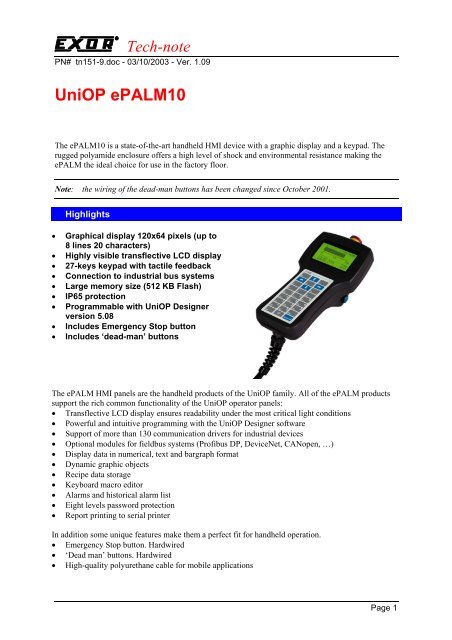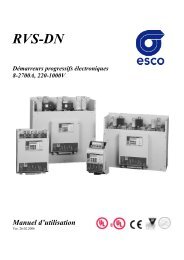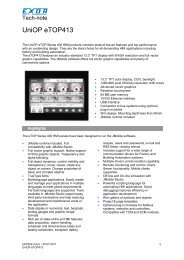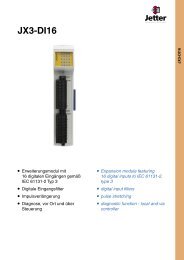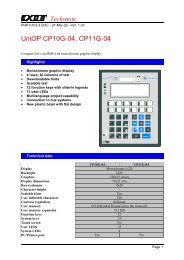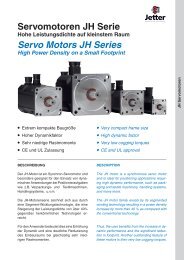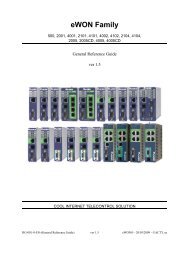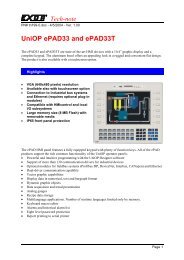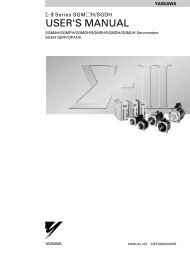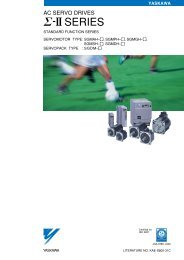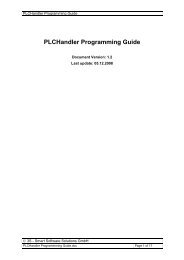UniOP ePALM10
UniOP ePALM10
UniOP ePALM10
You also want an ePaper? Increase the reach of your titles
YUMPU automatically turns print PDFs into web optimized ePapers that Google loves.
Tech-note<br />
PN# tn151-9.doc - 03/10/2003 - Ver. 1.09<br />
<strong>UniOP</strong> <strong>ePALM10</strong><br />
The <strong>ePALM10</strong> is a state-of-the-art handheld HMI device with a graphic display and a keypad. The<br />
rugged polyamide enclosure offers a high level of shock and environmental resistance making the<br />
ePALM the ideal choice for use in the factory floor.<br />
Note: the wiring of the dead-man buttons has been changed since October 2001.<br />
Highlights<br />
• Graphical display 120x64 pixels (up to<br />
8 lines 20 characters)<br />
• Highly visible transflective LCD display<br />
• 27-keys keypad with tactile feedback<br />
• Connection to industrial bus systems<br />
• Large memory size (512 KB Flash)<br />
• IP65 protection<br />
• Programmable with <strong>UniOP</strong> Designer<br />
version 5.08<br />
• Includes Emergency Stop button<br />
• Includes ‘dead-man’ buttons<br />
The ePALM HMI panels are the handheld products of the <strong>UniOP</strong> family. All of the ePALM products<br />
support the rich common functionality of the <strong>UniOP</strong> operator panels:<br />
• Transflective LCD display ensures readability under the most critical light conditions<br />
• Powerful and intuitive programming with the <strong>UniOP</strong> Designer software<br />
• Support of more than 130 communication drivers for industrial devices<br />
• Optional modules for fieldbus systems (Profibus DP, DeviceNet, CANopen, …)<br />
• Display data in numerical, text and bargraph format<br />
• Dynamic graphic objects<br />
• Recipe data storage<br />
• Keyboard macro editor<br />
• Alarms and historical alarm list<br />
• Eight levels password protection<br />
• Report printing to serial printer<br />
In addition some unique features make them a perfect fit for handheld operation.<br />
• Emergency Stop button. Hardwired<br />
• ‘Dead man’ buttons. Hardwired<br />
• High-quality polyurethane cable for mobile applications<br />
Page 1
Tech-note<br />
PN# tn151-9.doc - 03/10/2003 - Ver. 1.09<br />
Technical data<br />
<strong>ePALM10</strong><br />
Display<br />
Graphic resolution<br />
120x64 pixels<br />
Active display area<br />
66 x 33 mm<br />
Rows/columns<br />
8x20<br />
Character height -<br />
Scalable fonts<br />
Yes<br />
User definable characters 256<br />
Contrast regulation<br />
Software<br />
Brightness regulation No<br />
Memory<br />
User memory<br />
512 KB Flash<br />
User memory expansion -<br />
Front panel<br />
Function keys 9<br />
System keys 18<br />
Touch screen<br />
No<br />
User LED’s 20<br />
System LED’s 5<br />
Connections<br />
PC/Printer port<br />
PLC port<br />
Aux port (fieldbus<br />
connection)<br />
External keyboard port<br />
Programming speed<br />
Yes<br />
RS-232, RS-485, RS-422<br />
Yes, with optional modules<br />
No<br />
9600 – 38400 bps<br />
Functionality<br />
Page size<br />
32 rows<br />
Number of variables per page Unlimited<br />
Recipe memory<br />
16 KB<br />
UniNet network<br />
Client/Server<br />
Alarms 1024<br />
Event list 256<br />
Alarm info page<br />
Yes<br />
Password<br />
Yes<br />
Battery<br />
Yes. User replaceable lithium battery model Duracell DL2430<br />
Hardware RTC<br />
Yes<br />
Screen saver<br />
No<br />
Buzzer<br />
No<br />
Power supply voltage 18 - 30 VDC<br />
Max power consumption ~ 300 mA at 24 VDC<br />
Fuse<br />
Automatic<br />
Weight<br />
~ 0.5 Kg (not including cable)<br />
Operating temperature 0 to 50 °C<br />
Storage temperature -20 to +70 °C<br />
Page 2
Tech-note<br />
PN# tn151-9.doc - 03/10/2003 - Ver. 1.09<br />
Operating and storage<br />
humidity<br />
Protection class<br />
Min diameter of cable<br />
Max diameter of cable<br />
5 – 95 % RH non-condensing<br />
IP65<br />
7 mm<br />
11 mm<br />
The product is designed for installation in an industrial environment in compliance with the<br />
regulations:<br />
Emitted interference EN 61000-6-4, 2001<br />
Noise immunity EN 61000-6-2, 2001<br />
All circuits in the handheld, including the wiring for the emergency stop button and the deadman<br />
buttons, must be considered SELV circuits. They will have to be used in compliace with EN 60950.<br />
Dimensions<br />
A 116 mm 4.56”<br />
B 86 mm 3.38”<br />
C 102 mm 4.01”<br />
D 239 mm 9.41”<br />
A<br />
D<br />
C<br />
B<br />
Page 3
Tech-note<br />
PN# tn151-9.doc - 03/10/2003 - Ver. 1.09<br />
Connections<br />
The unit provides all standard <strong>UniOP</strong> connections (PC/Printer Port, PLC Port, Aux Port, power) plus<br />
some special signals (Emergency Stop button – two NC contacts, “dead-man” buttons – two<br />
independent NO contacts) on the internal terminal block.<br />
Note: the <strong>ePALM10</strong> unit does not include a current loop (20 mA) interface on the PLC port. The<br />
communication modules TCM04 (Interbus), TCM07 (Simatic S7 MPI without optical<br />
insulation) and TCM10 (Ethernet) are not supported.<br />
The internal terminal block is a detachable module with five terminal blocks. The position of the<br />
connectors and the numbering of the contacts are shown in the figure below. The board shown in<br />
figure will be referred as CA01 interface board.<br />
CN2<br />
CN1<br />
CN3<br />
CN5<br />
CN4<br />
The assignment of the signals on the connectors is shown in the tables below. Terminals indicated as<br />
‘Reserved’ should not be used.<br />
CN1 Aux Port<br />
CN2 PC/Printer Port<br />
1 Aux Port pin 5 1 Reserved<br />
2 Aux Port pin 9 2 Reserved<br />
3 Aux Port pin 4 3 Reserved<br />
4 Aux Port pin 8 4 Reserved<br />
5 Aux Port pin 3 5 +5V output (max 100 mA)<br />
6 Aux Port pin 7 6 GND<br />
7 Aux Port pin 2 7 RXD<br />
8 Aux Port pin 6 8 CTS<br />
9 Aux Port pin 1 9 TXD<br />
10 Reserved 10 RTS<br />
Page 4
Tech-note<br />
PN# tn151-9.doc - 03/10/2003 - Ver. 1.09<br />
The terminal assignment in CN1 refers to the equivalent assignment in the Aux Port of the standard<br />
panel-mount version of the product. This correspondence will be useful to adapt the normal cable<br />
drawings for use with the handheld device.<br />
CN3 PLC Port<br />
CN4 Power<br />
1 CHA+ 1 +24 VDC<br />
2 CHA- 2 Common<br />
3 CHB+ 3 Reserved<br />
4 CHB- 4 PE<br />
5 +5V output (max 100 mA)<br />
6 GND CN5 Additional Signals<br />
7 RXD 1 Dead man button R (NO contact)<br />
8 CTS 2 Dead man button R (NO contact)<br />
9 TXD 3 Dead man button L (NO contact)<br />
10 RTS 4 Dead man button L (NO contact)<br />
The Emergency Stop button is hardwired directly to the cable: the corresponding signals do not<br />
appear listed in the connectors.<br />
The <strong>ePALM10</strong>-0061 includes a communication cable with a length of 5 meters. The cable does not<br />
have a connector on its free end as it is intended to be wired directly in the control cabinet.<br />
The connections are color-coded according to the table below.<br />
Signal Color S mm 2 AWG (approx)<br />
Power<br />
+24 VDC Red 0.5 20<br />
Common Black 0.5 20<br />
PC/Printer Port<br />
GND Grey 0.14 26<br />
RXD Orange 0.14 26<br />
CTS Brown 0.14 26<br />
TXD White 0.14 26<br />
RTS Pink 0.14 26<br />
+5V Output Green 0.14 26<br />
PLC Port<br />
CHA+ Blue-Red 0.14 26<br />
CHA- Blue-Black 0.14 26<br />
CHB+ Violet-Red 0.14 26<br />
CHB- Violet-Black 0.14 26<br />
+5V Output Red 0.14 26<br />
GND Black 0.14 26<br />
RXD Brown-Pink 0.14 26<br />
CTS Green-Pink 0.14 26<br />
TXD Orange-Pink 0.14 26<br />
RTS Yellow-Pink 0.14 26<br />
Additional Signals<br />
DM Right (NO) Cyan-Black 0.35 22<br />
DM Right (NO) Cyan 0.35 22<br />
DM Left (NO) Blue-Black 0.35 22<br />
DM Left (NO) Blue 0.35 22<br />
Page 5
Tech-note<br />
PN# tn151-9.doc - 03/10/2003 - Ver. 1.09<br />
Emergency Stop<br />
E-Stop 1 (NC) Green 1 17<br />
E-Stop 1 (NC) Yellow 1 17<br />
E-Stop 2 (NC) Brown 1 17<br />
E-Stop 2 (NC) Orange 1 17<br />
The internal layout of the communication cable is shown in the figure below. Please note that the<br />
ferrite toroid is required.<br />
Note: the wiring of the Emergency Stop button is to be considered a SELV circuit and it is<br />
intended only for connection to low voltage circuits (below 48 VDC).<br />
The standard cable layout of the <strong>ePALM10</strong>-0061 and <strong>ePALM10</strong>-0062 includes the signals of the<br />
PC/Printer Port and the signals of the PLC Port. It will allow, without further modification, to connect<br />
to the handheld device for programming and to set-up a connection to a field device using RS-232,<br />
RS-422 and RS-485.<br />
If connection to the Aux Port is required, connections wired to the PLC port will have to be manually<br />
moved to the Aux Port.<br />
When the RS-422 or RS-485 communication is used, it is recommended not to leave floating the<br />
RXD and the CTS signals (that are not used in this configuration). The RXD signal it to be connected<br />
to GND, the CTS signal is to be connected to the +5V Output.<br />
N.C.<br />
N.C.<br />
N.C.<br />
N.C.<br />
GREEN<br />
GREY<br />
ORANGE<br />
BROWN<br />
WHITE<br />
PINK<br />
Max Wire Length 10cm<br />
To Emergency Stop<br />
Button<br />
N.C.<br />
N.C.<br />
N.C.<br />
N.C.<br />
N.C.<br />
N.C.<br />
N.C.<br />
N.C.<br />
N.C.<br />
N.C.<br />
CYAN-BLACK<br />
CYAN<br />
BLUE-BLACK<br />
BLUE<br />
YELLOW<br />
GREEN<br />
BROWN<br />
ORANGE<br />
4X1mmq<br />
Length 25cm<br />
BLUE-RED<br />
BLUE-BLACK<br />
VIOLET-RED<br />
VIOLET-BLACK<br />
RED<br />
BLACK<br />
BROWN-PINK<br />
GREEN-PINK<br />
ORANGE-PINK<br />
YELLOW-PINK<br />
RED<br />
BLACK<br />
N.C.<br />
SHIELD TRACE<br />
Connect the<br />
Shield Trace<br />
Ferrite Toroid<br />
The figure shows the assembly of the communication cable.<br />
Please note that the ferrite toroid (included in the <strong>ePALM10</strong> package) is required for proper operation.<br />
Page 6
Tech-note<br />
PN# tn151-9.doc - 03/10/2003 - Ver. 1.09<br />
To program the <strong>ePALM10</strong> you will need to wire at least the power supply and the programming port<br />
connections. Connect the <strong>ePALM10</strong> to the COM port of a PC as indicated in the figure below.<br />
Using Optional Fieldbus Modules<br />
The ePALM handheld HMI can use some of the standard TCM communication modules for<br />
connection to fieldbus systems.<br />
The list of the TCM module currently supported by the ePALM product is the following:<br />
TCM module Fieldbus Notes<br />
TCM01 Siemens Simatic S7 MPI Suitable for a point-to-point<br />
configuration<br />
TCM02 Moeller Suconet K Suitable for a point-to-point<br />
configuration<br />
TCM03 DeviceNet There are limitations in the bus speed<br />
and network configuration that can be<br />
used<br />
TCM08 Profibus DP There are limitations in the bus speed<br />
and network configuration that can be<br />
used<br />
TCM09 CANopen There are limitations in the bus speed<br />
and network configuration that can be<br />
used<br />
Other TCM modules are currently not supported for use in the ePALM products.<br />
The following notes are important:<br />
• The TCM module must be plugged into the unit. The ePALM must be opened to allow for the<br />
insertion of the TCM module. After plugging the module the ePALM product must be carefully<br />
closed to ensure proper sealing.<br />
• The default wiring of the Aux Port CN1 must be manually changed to connect the appropriate<br />
signals. Fieldbus topologies do not allow long (5-10 meters) drop segments; the wiring must<br />
include incoming and outcoming segments for all bus signals.<br />
• The CA01 interface board does not allow adding terminator resistors to the bus lines. The ePALM<br />
cannot be used a final node in the network topology unless termination resistors are applied<br />
externally.<br />
The most common wiring layouts will be described in detail in this chapter.<br />
Page 7
Tech-note<br />
PN# tn151-9.doc - 03/10/2003 - Ver. 1.09<br />
Connecting the ePALM to the Simatic S7 MPI network<br />
It is recommended that the necessary wires are moved from the CN3 connector (PLC Port) to the CN1<br />
connector (Aux Port).<br />
We suggest to wire the connections as shown in the table below.<br />
The table indicates the wires that must be moved from CN3 to CN1. The signals A and B will have to<br />
be connected to the MPI network.<br />
Please note that it is not possible to connect the termination resistors in the ePALM.<br />
CN1 Connector (Aux Port)<br />
CN3 Connector (PLC Port)<br />
Wires to be removed<br />
Pin Signal Color Pin Signal<br />
4 A Blue-Red 1 CHA+<br />
5 B Blue-Black 2 CHA-<br />
1 GND Black 6 GND<br />
Page 8
Tech-note<br />
PN# tn151-9.doc - 03/10/2003 - Ver. 1.09<br />
Indicators and Keypad<br />
The standard keypad of the ePALM panels is shown in the figure below.<br />
Custom artwork may be designed and produced on request. Please inquire for more information.<br />
Uni OP<br />
091A<br />
There are several dedicated LED indicators on the front panel of the unit. Functions are described in<br />
the table below.<br />
LED Color Status Meaning<br />
red OFF No hardware problems detected<br />
BLINK Battery low<br />
ON Hardware fault<br />
green OFF No key pressed<br />
ON While any key is pressed (visual feedback)<br />
green OFF Hardware fault<br />
ON Unit in operation<br />
green BLINK Communication error<br />
ON Communication OK<br />
red OFF No alarms<br />
BLINK Alarm requires acknowledgment<br />
ON Alarm active<br />
green May be user controlled as LED number 65<br />
using the Macro Editor. Turns ON when<br />
recipe/event backup is being performed.<br />
Page 9
Tech-note<br />
PN# tn151-9.doc - 03/10/2003 - Ver. 1.09<br />
The RDA mapping of LED indicators is shown in the table below.<br />
RDA Bit LED on Key RDA Bit LED on Key<br />
L1 F1 L17<br />
L2 F2 L18 1<br />
L3 F3 L19 2<br />
L4 F4 L20 3 /<br />
L5 F5 L21 4<br />
L6 F6 L22 5<br />
L7 F7 L23 6 /<br />
L8 F8 L24 7<br />
L9 F9 L25 8<br />
L10 L26 9 /<br />
L11 L27 .<br />
L12 L28 +/-<br />
L13<br />
L29<br />
L14<br />
L30<br />
L15<br />
L31<br />
L16<br />
L32<br />
The RDA mapping of the keypad is standard.<br />
Battery Replacement<br />
A lithium battery is required for data back-up. The following information is maintained by the battery:<br />
• Hardware real time clock<br />
• Event list<br />
• Recipe data<br />
Note: replacing the battery will cause the loss of the data maintained by the battery.<br />
To replace the battery follow the procedure listed below:<br />
1) turn off the power to the device<br />
2) using a screwdriver loose the 6 screws securing the plastic enclosure<br />
3) open the handheld; the battery is located on the CPU subsystem<br />
4) remove the battery<br />
5) replace the battery with a new one<br />
6) close the handheld and tighten the six screws<br />
7) apply power to the handheld and check that the battery good status is reported.<br />
Battery<br />
Page 10
Tech-note<br />
PN# tn151-9.doc - 03/10/2003 - Ver. 1.09<br />
Accessories<br />
The following accessories are currently available for the <strong>ePALM10</strong> products:<br />
• hooks for hanging the handheld device. Hooks are available in two versions, AHOOK01 without<br />
magnet and AHOOK02 with a magnet.<br />
The hook with the magnet is shown in the figure below.<br />
Ordering Information<br />
<strong>ePALM10</strong>-0061<br />
<strong>ePALM10</strong>-0062<br />
AHOOK01<br />
AHOOK02<br />
<strong>ePALM10</strong> HMI with cable (length 5 meters)<br />
<strong>ePALM10</strong> HMI with cable (length 10 meters)<br />
Hook set without magnet<br />
Hook set with magnet<br />
Tn151<br />
Copyright © 2001 Sitek S.p.A. Italy<br />
Subject to change without notice<br />
www.exor-rd.com<br />
Page 11


